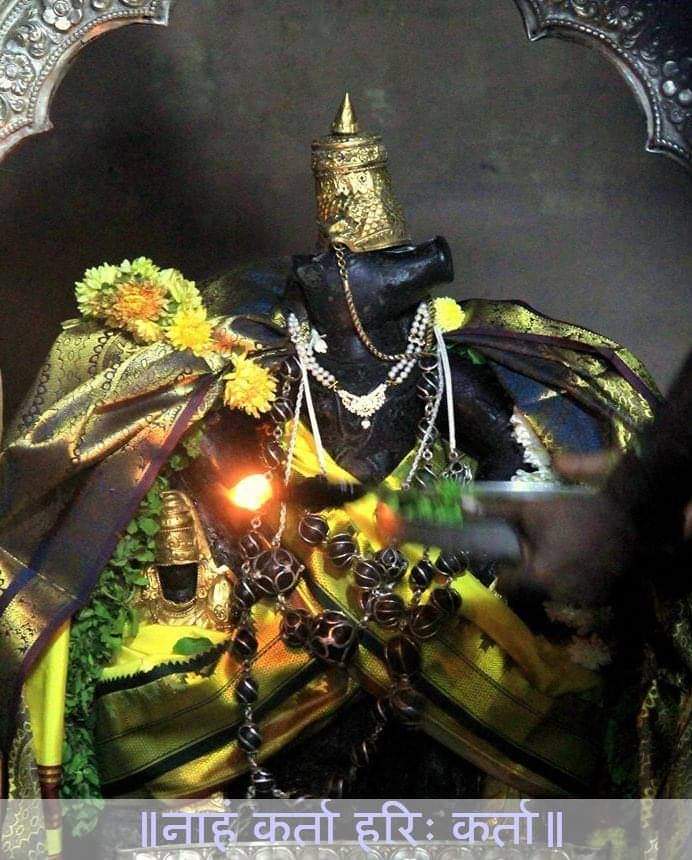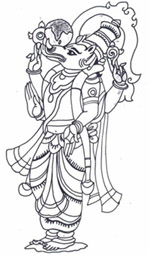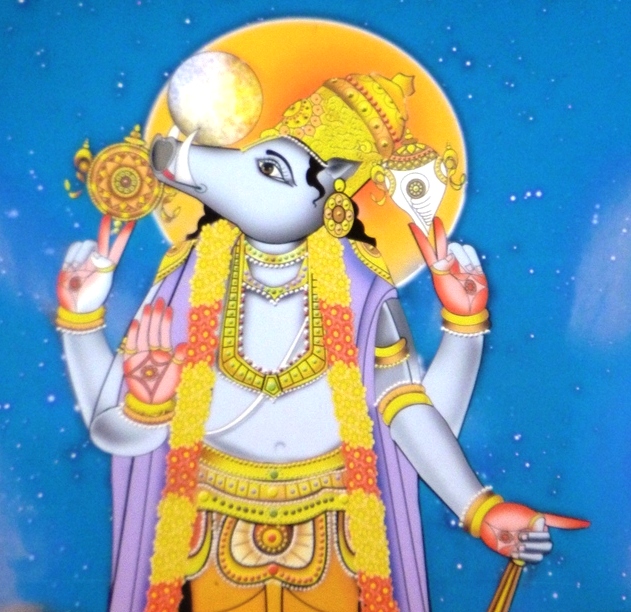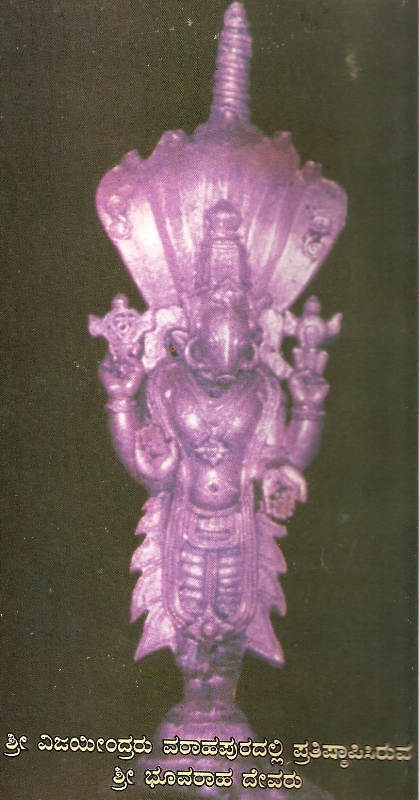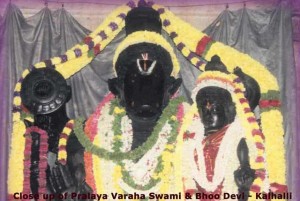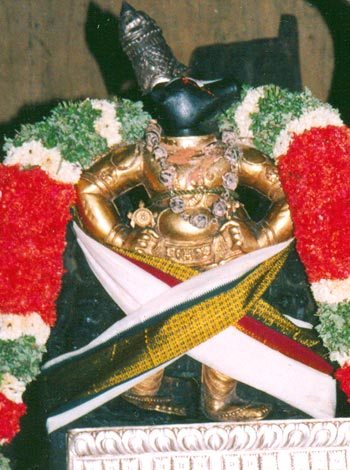Varaaha Jayanthi (ವರಾಹ ಜಯಂತಿ)
ಭಾದ್ರಪದ ಮಾಸದ ಶುಕ್ಲ ಪಕ್ಷದ ತೃತೀಯ
ಶ್ರೀಹರಿಯ ಮೂರನೇ ಅವತಾರವೇ “ವರಾಹಾವತಾರ”
ಆಚಾರ್ಯ ಮಧ್ವರು ವರಾಹಾವತಾರವು ಎರಡು ಬಾರಿ ಆಗಿದೆ ಎಂದಿದ್ದಾರೆ. ಒಮ್ಮೆ ಆದಿ ಹಿರಣ್ಯಾಕ್ಷ ಭೂಮಿಯನ್ನು ಹೊತ್ತು ನೀರಿನಲ್ಲಿ ಮುಳುಗಿಸಿದ್ದಾಗ ಬ್ರಹ್ಮದೇವರ ಮೂಗಿನಿಂದ ಅವತರಿಸಿ, ಅವನನ್ನು ಸಂಹರಿಸಿದನು. ಮತ್ತೊಮ್ಮೆ ಕಶ್ಯಪರ ಮಗ ಹಿರಣ್ಯಾಕ್ಷ ಭೂದೇವಿಯ ಹೊತ್ತು ನೀರಿನಲ್ಲಿ ಮುಳುಗಿಸಿದಾಗ ವರಾಹಾವತಾರವಾಗಿದ್ದು ಹಿರಣ್ಯಾಕ್ಷನ ಕೊಂದನು.
Sri Vaadiraaja yati virachita Dashaavatara stuti
Varaaha Stotra :
ನೀಲಾಂಬುದಾಭ ಶುಭಶೀಲಾದ್ರಿ ದೇಹಧರ ಖೇಲಾಹೃತೋದಧಿಧುನೀ
ಶೈಲಾದಿಯುಕ್ತನಿಖಿಲೇಲಾಕಠಾಧ್ಯಸುರ ತೂಲಾಟವೀದಹನ ತೇ |
ಕೋಲಾಕೃತೇ ಜಲಧಿಕಾಲಾಚಲಾವಯವ ನೀಲಾಬ್ಜದಂಷ್ಟ್ರಧರಣೀ
ಲೀಲಾಸ್ಪದೋರುತಲಮೂಲಾಶಿಯೋಗಿವರ ಜಾಲಾಭಿ ವಂದಿತ ನಮ: ||
नीलांबुदाभ शुभशीलाद्रिदेहधर खेलाहृतोदधिधुनी
शैलादियुक्तनिखिलेलाकठाध्यसुर तूलाटवीदहन ते ।
कोलाकृते जलधिकालाचलावयव नीलाब्जदंष्ट्रधरणी
लीलास्पदोरुतलमूलाशियोगिवर जालाभि वंदित नम: ॥
In Vishnu sahasranaama stotram, the name “mahavaraaha:” has been attributed to Srihari; as he destroyed the great daithyaas or he is called as Mahavaraaha as he came out of the nose of Brahma and took the boar (pig) avataara.
Who is Varaha ? – This is the avataara of Srihari to kill daithya Hiranyaksha and bringing back the earth. This is the third amongst the dashavataara. Acharya Madhwa has clarified that Varahavatara has happened twice. The varaha roopa has the head of boar (pig type) and the body of a human.
Necessity of the birth of Varaha – Chaturmukha Brahma, who took the birth from the Padma, the novel of paramatma, created “Swayambu manu” and others. Hiranyaksha, who was born from Brahma Devaru had taken the entire bhoomi and dragged it to waters. All the gods, appeared before Brahma devaru. At that time, Narayana appeared in the form of a tiny Varaha rupa from the nose of Brahma. The little Varaha which came out of the nose of Brahma, grew, grew and grew like that of a mountain to every body’s surprise.
We are doing the sankalpa by saying Shwetha varaaha kalpe – That means we are in the first day (only day) called Swetha Varaha Kalpa in the 51st year of Lord Brahma. In Swetha Varaha Kalpa (first day of Lord Brahma) after passing through 6 Manvantharas out of 14 we are currently in the 7th Manvanthara called Vaivaswatha Manvanthara.
Chintana of Varaha Roopi Paramathma as per Tantrasara sangraha of Acharya Madhwa :
ಶ್ಯಾಮ: ಸುದರ್ಶನ ದರಾಭಯ ಸದ್ವರೇತೋ |
ಭೂಮ್ಯಾ ಯುತೋಽಖಿಲ ನಿಜೋಕ್ತ ಪರಿಗ್ರಹೈಶ್ಚ |
ಧ್ಯೇಯೋ ನಿಜೈಶ್ಚ ತನುಭಿ: ಸಕಲೈರುಪೇತ: |
ಕೋಲೋ ಹರಿ: ಸಕಲ ವಾಂಛಿತ ಸಿದ್ಧಯೇಽಜ: ||
श्याम: सुदर्शन दराभय सद्वरेतो ।
भूम्या युतोऽखिल निजोक्त परिग्रहैश्च ।
ध्येयो निजैश्च तनुभि: सकलैरुपेत: ।
कोलो हरि: सकल वांछित सिद्धयेऽज: ॥
Varaha roopi paramathma’s body colour is blue. He has Chakra,- Shanka,- abhaya and vara mudre in his four arms. He is accompanied by Bhoodevi and his entire parivara of Brahma Rudraadi devate. We have to do the smarana of Srihari for our SakalaabhiShta siddhi.
Varaha devaru in Tirupathi – In Srinivasa Kalyana, we can see the story of Varaha Devaru. Srinivasa came to Tirupathi and sought some place with Varaha Devaru for his stay. Varaha, the other roopa of Srihari agreed and gave him some space and in return Srinivasa offered him the first darshana to Varaha before Srinivasa at Tirumala. The first naivedya shall be offered to Varaha Devaru then to Srinvasa.
Why he is called Yajna Varaha – As the items required for Yajna, came out of the body of Varaha roopi paramaathma, and he is the yajna bhoktru also, he is called as Yajna Varaha.
Varaha devaru has other names like Kroda, Sookara, DharaNidhara, Bhoodhara, Mahidhara, etc. In Vishnu Sahasranama, Srihari is called as “Maha varaha” which Acharya Madhwa has defined in Bruhadaaranyakanishad Bhashya – as
mahanIyatvaat maha: | shrEShTatvaat vara: | ahInatvaat daha: |
महनीयत्वात् मह: । श्रेष्टत्वात् वर: । अहीनत्वात् दह: ।
i.e., He is Sarvottama, Dosha doora and Gunapoorna \
महावरा: अतिनीचा: कल्यादयस्तानाहंतीति महावराह: |
ಮಹಾವರಾ: ಅತಿನೀಚಾ: ಕಲ್ಯಾದಯಸ್ತಾನಾಹಂತೀತಿ ಮಹಾವರಾಹ: |
As he pushes the kaliyaadi daithyaas, he is called as Mahavaraaha |
Acharya Madhwa prays in Dwadasha Stotra as
सूकर रूपक दानव शत्रो ।
भूमि विधारक यज्ञवरांग ।
ಸೂಕರ ರೂಪಕ ದಾನವ ಶತ್ರೋ |
ಭೂಮಿ ವಿಧಾರಕ ಯಜ್ಞವರಾಂಗ |
Varaha Devaru – Click for Picasa photo
Lord Vishnu in his incarnation as Lord Varaha,has lifted the earth which was hidden by the powerful daitya Hiranyaksha in the ocean, and killed the daithya Hiranyaksha.
Bhoovaraha devaru @ Kallahalli in Mandya District near Pandavapura
Lakshmi Varaha Temple located at Demal Village in Aul in Kendarpara District in Orissa is one such rare temple. The Varaha murti worshipped at the temple is made from a single piece of black stone. The temple also has the footprints of Lakshmi Varaha. Varaha is worshipped alongwith Sridevi and Bhoodevi.
Srimushnam – Varaha kshetra :
As per Narada Purana – Varaha Rupi paramathma brought back the Earth from sea and removed all the miseries of the world. Bhudevi prayed Varaha Devaru not to leave for Vaikunta and wished to worship him always. Pleased with the worship of Bhudevi Varaha devaru stayed at that place, where Bhumi (earth) was brought up – that place is none other than Srimushnam. Since Varahadevaru stays with Bhudevi, he is called as Bhuvaraha Murthy.
There are several tirthas in Srimushnam; viz., Nitya Pushkarini, Lakshminarayana saral, Bhumi Tirtha, Chakra Tirtha, Brahma Tirtha,Agni Tirtha, Danda Tirtha, Mrutyunjaya Tirtha, etc. where there is sannidhana of Agni, Brahma, Vayu,
In Srimushnam – Any daana done would fetch more punya.
Sri Vadirajaru has done the stotra of Sri Varaha Devaru in Srimushnam – Shwetha Varaha as follows –
ಶ್ರೀಮುಷ್ಣಂ ಕ್ಷೇತ್ರ – ಶ್ರೀಭೂವರಾಹ – श्रीमुष्णं क्षेत्र – श्रीभूवराह – as per Vadirajaru in Tirtha prabandha –
ವರಾಹ ವರದಂಷ್ಟ್ರಯಾ ಕುಟಿಲಯಾ ಕಠೋರಂ ರಿಪುಂ
ವಿದಾರ್ಯ ಸುರಧುರ್ಯ ಗಾಂ ನಿಜಪದಾರವಿಂದಾನುಗಾಂ |
ಉಪೇತ್ಯ ಸುಖಚಿತ್ತನು: ಸರಸಲೀಲಯಾಽಽಲಿಂಗ್ಯ
ತಾಂ ಸಿತಾಂಗ ಜಗತಾಂ ಗತೇ ವಿಹರಸೀಹ ಪುಣ್ಯಸ್ಥಲೇ || ೪೧ ||
वराह वरदंष्ट्रया कुटिलया कठोरं रिपुं विदार्य सुरधुर्य गां निजपदारविंदानुगां ।
उपेत्य सुखचित्तनु: सरसलीलयाऽऽलिंग्य तां सितांग जगतां गते विहरसीह पुण्यस्थले ॥ ४१ ॥
Sri Varaha devaru, the Shwetha Varaha is the final destiny of the entire world. – You are the supreme of all devataas – You tore off the cruel and daitya Hiranyaksha with your teeth – You are Sukachit tanu, i.e., your body consists of ever happiness and jnaana – you are sporting in Srimushnam kshetra by embracing Bhudevi romantically.
Srimushnam is one of the swayamvyakta kshetra where we can find Bhuvaraha Devaru. This is also called as Varaha Kshetra. The vigraha in Bhoovaraha ksheta is not sculptured by any human but is a formation of the stone saligarama (black smooth round stone) and is also called ‘Yagna Varaha’. It is said that lord vishnu resides in this particular place in three forms. One in the form ‘Ashwatha tree’, second as ‘Nithya Pushkarani’ and as ‘Bhoovaraha Swamy’.
It is said to be the ‘Avatara sthala’ of Sri Varaha swamy. After Sri Vishnu killed daithya Hiranyaksha who was under the sea taking the earth, Sri Varaha is said to have rested at this place with the water sweating from his body forming the pushkarni here. Hence a bath at this pushkarni is very much sacred.
It is said that in this kshetra, the Varahadevaru is worshipped first by Brahmadevaru and Saraswathi devi.
Sri Acharya Madhwa was camping in Srimushnam a place twenty-six Km from Chidambaram in Tamil Nadu, observing the Chathurmasya vritha. To remove the thirst of a pregnant lady he produced water with his Danda. The Danda Teertha in Srimushnam is a notable holy spot for Maadhwas. This Danda theertha is about 2 km from the temple and about 1 km walkable distance from the main road. In this way, there is presence of Sri Hari (as Varaha) and Sri Vayu (Danda tirtha).
Srimushnam Varaha utsava murthy and Uttaradimutt – It is traditional privilege that whenever a seer of Uttaradimutt visits Srimushnam, the Utsava murthy with Sridevi and Bhudevi would come to the mutt and puja is performed the UM Swamiji to those deities along with Ramadevaru. It is in practice since Sri Satya poorna Tirtharu’s period. Sri Satyatma Tirtha Mahan has recently built building at Danda Tirtha and renovated for the benefit of the devotees here.
Places nearby :
Tirukkoilur – 20 km to Vriddachalam – 40 km to Villupuram – 35 km from Villupuram to Tirukkoilur
